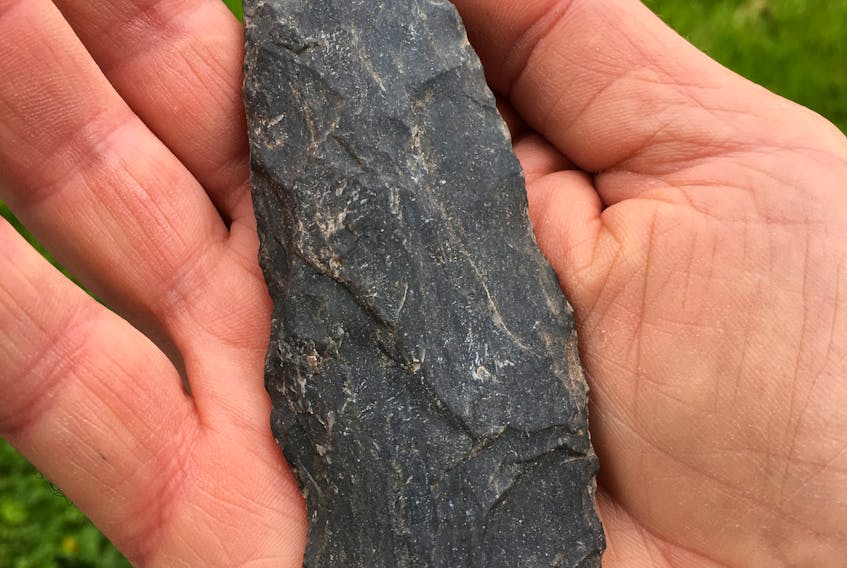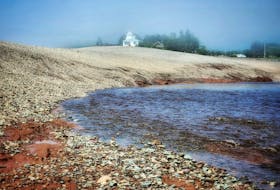A quick stop to let his dog drink from a brook led to a historic discovery for a Pictou County man this past year and offers a glimpse into life in the province thousands of years ago.
Alan Elliott, who happens to work for The News, was out for his usual morning walk with his dog in the Scotsburn area in May 2017 when he stopped at a stream. As the dog drank, Elliott saw something on the edge that caught his attention – a stone flaked on both sides and with a point.
What he’s learned in the months that followed is that the tool he found is a rare 3,000-year-old spearhead or knife that would have been used by Aboriginal people. The only other find of this kind in Northern Nova Scotia was a similar tool found in the 1980s on Dalhousie Mountain.
For Elliott it was a dream come true.
Growing up in Ontario, he said he would hear stories of farmers plowing in their fields and discovering arrowheads.
“I always thought, ‘Oh man do I wish I could find something like that.’”
In university during the 1970s he took some anthropology courses that included information on how Native North Americans lived and made tools, which sparked his interest even more. So it’s become habit for him to keep his eyes on the ground while out for walks.
“Many times I’ve picked up something that’s roughly arrowhead shaped and you pick it up and it turns out to be a lump.”
But that May day was different. The approximately 5 ½-inch-long stone was clearly unique.
“When I turned it over I could see it was flaked on both sides. It was obviously made as a blade and it was symmetrical, so I knew it was genuine.”
He rushed home and showed it to his family, but quickly realized he should report it. The first place he phoned was the Museum of Industry where he was put in touch with Debra McNabb, who photographed the item and sent pictures to the Museum of Natural History.
At that point, Elliott said he had no idea whether it was something common or not.
“I thought, maybe they have dozens of these, but maybe they don’t.”
When she received photos of the discovery and heard where it was from, Katie Cottreau-Robins, archaeology curator for the Nova Scotia Museum, was instantly intrigued and made plans to come out to have a look.
She said the stone implement, which she calls a bi-face, appears to be from the Late Archaic Period, estimating it at about 3,000 years old. She said that is determined by comparing it to other collections including ones from other Atlantic provinces and Maine. By comparing it to the style and type of stone used in other parts, they can determine an approximate age.
She said this particular tool was likely a spearhead for hunting or a blade that would have been used to skin animals. It was made of rhyolite, which was quarried extensively by Native Americans.
Around that time period, Aboriginal people in Nova Scotia would have likely hunted caribou, moose and beaver inland and sea mammals along the coast.
“I was excited about it because we don’t have a lot of Late Archaic sites in that part of the province,” she said.
The nearest discovery of this type from the late Archaic Period was on Dalhousie Mountain in the late 1980s.
“That’s really it for that period for that part of the province,” she said.
Larger finds from the era have been made in Yarmouth and Kings counties and archaeologists speculate that some of the sites inhabited by aboriginals may now be underwater because of rising sea levels.
She and a team visited with Elliott in November to look at the site where he discovered the particular item.
“We had a good look around for other artifacts and for characteristics that might indicate a site,” she said.
While it appears it was an isolated item, she’s still happy to have found it because it’s one more piece in the puzzle of life in Nova Scotia.
The item will soon be on display at the Museum of Natural History for others to admire.
Elliott for his part will be keeping his eyes on the ground for the chance that just maybe he’ll find another similar item, but he’s content having his lifelong wish come true.
“To think that probably the last person who held that was an Aboriginal 3,000 years ago is incredible.”
It amazes him to think how at that time when fishing and hunting were part of everyday life, they had to fashion the tools they needed.
“They couldn’t go to the hardware store. They have to make that from scratch, from the right kind of stone that comes from the right place,” he said. “It’s just amazing to me to see that kind of thing. It shows the kind of work and thought that would have to go into that livelihood.”
What to do if you find a historic item
If you find an item you believe may have historical significance, such as an arrowhead, Katie Cottreau-Robins encourages you to contact the Museum of Natural History.
“We’re always interested in what they find and we’re accessible,” she said.
She said people can email photos of their discovery and if it’s believed to warrant further interest, as in the case of Alan Elliott’s find, they’ll follow up.
It’s much appreciated when people are willing to donate the item they find to the Museum.
“We really hope they will donate. We like to share what they find.”
To contact the Museum of Natural History call (902) 424-2170 or email [email protected].
Life around the world 3,000 years ago.
Egypt: the New Kingdom era was collapsing
Mesopotamia: Babylon was in decline
Greece: Greece was beginning a period which would later be known as the Dark Ages characterized by the loss of Mycenaean writing
Rome: there was no city of Rome, only seven hills with a few hamlets
South Asia: the Aryans were settling on the plain of the Ganges River
Pacific Ocean Islands: the Lapita people were sailing to New Caledonia, Fiji, Samoa, and Tonga
China: the Zhou dynasty was in its first century of rule
Middle East: the Hebrew tribes were uniting under the leadership of Saul
Europe: the Celtic migrations were beginning
Mesoamerica: the Mayans were draining swamps to create new farmlands
SOURCE: http://nativeamericannetroots.net/diary/994









